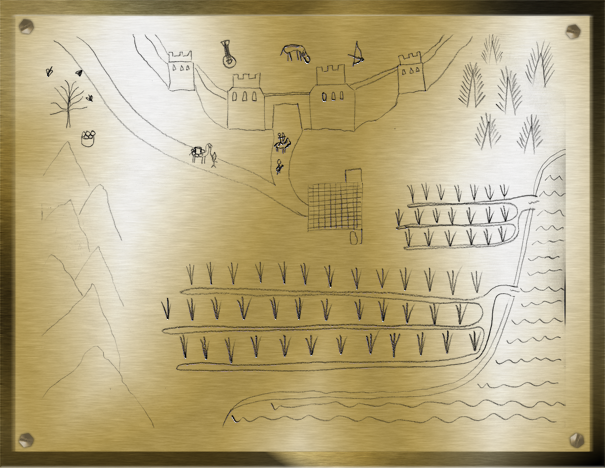| Time Period | Tang Dynasty: High Tang |
| Geographical Region | Great Wall to Hainan, East China Sea to Dunhuang |
| List of Symbols |
|
Chinese Society flourished during the Tang Dynasty. The Empire was one of the largest of its time, spanning from the Great Wall built in the north during the Qin Dynasty all the way to the ocean in the south, and from coast in the east all the way to the mountains in the west. These geographic landmarks are included in the plaque, so that future viewers know where the Tang Empire is situated.
There are several things that might remind future civilization of the Tang Dynasty, one of which are is the production of silk shown by the mulberry trees, hatched silkworms and a basket of silkworm cocoons in the upper left-hand corner of the plaque. It represents the monopoly of silk production China, or the Tang Empire, experienced at the time. A large number of mulberry trees were grown around the northwestern part of the empire, a certain share of which would belong to various groups of farmers, which was the result of a policy implemented at the beginning of the empire.
Next to the mulberry tree, one can see a foreign merchant travelling along the trade routes to the Empire’s capital in Chang’an. The traveller leading a camel represents the extent to which merchants and their goods would travel on the well-known “Silk Roads”. On the roads coming from the north, two more travellers can be found, one on a horse, the other carrying a pipa. These two travellers also show that the Tang Dynasty engaged in serious trade with its northern neighbors, the Uighur and Mongol tribes. These tribes brought with them horses, bow and arrows, as well as the pipa, all shown beyond the Great Wall to depict that these inventions were foreign, the latter of which had a serious impact on Chinese culture. The open gate through which the northern travellers and merchants pass through is meant to show how open the Chinese were to foreign trade and foreign influence under the Tang rule.
In the center of the plaque, I have drawn in the city structure of Chang’an during the time of the Tang dynasty. It was the first to implement a structure in which various households would like within separate “courts”. The gates to each court would be locked at night, and the outer walls of the city would do the same. This, again, influenced a variety of stories written during this time period. At the same time, the city structure also represents the structured government and census at the time, another thing for which the Tang Empire is known.
To the right and below the capital’s structure, one can see rice seedlings planted in neat rows. Like the mulberry trees, the rice seedlings show the implementation of a new agricultural system, incorporating the newly found techniques for rice planting. Rice quickly became the main staple food in the south, and its abundance caused its spread of popularity throughout the rest of the empire. As the capital did not grow enough of its food in the surrounding areas, the canals from the past dynasty were widely used to ship rice grown in the south to the capital in the relative north, thereby supplying most of the population in the capital with rice as a major food source. Each of the rows of rice seedlings also corresponds to a specific waterway, which is meant to represent the advance of the Chinese Irrigation system of the time. The spread of rice caused a need for a larger supply, which was only achieved by advancing the irrigation system.
 JACQUELINE HEINZELMANN is a student at the University of Rochester. Jacqueline, who goes by Jackie, studies International Relations and East Asian Studies. When she is not busy writing essays for her various classes, she is probably reading. More by Jackie
JACQUELINE HEINZELMANN is a student at the University of Rochester. Jacqueline, who goes by Jackie, studies International Relations and East Asian Studies. When she is not busy writing essays for her various classes, she is probably reading. More by Jackie
